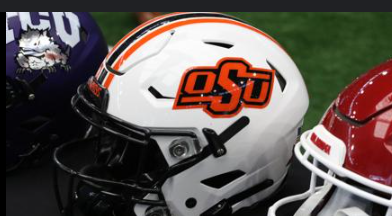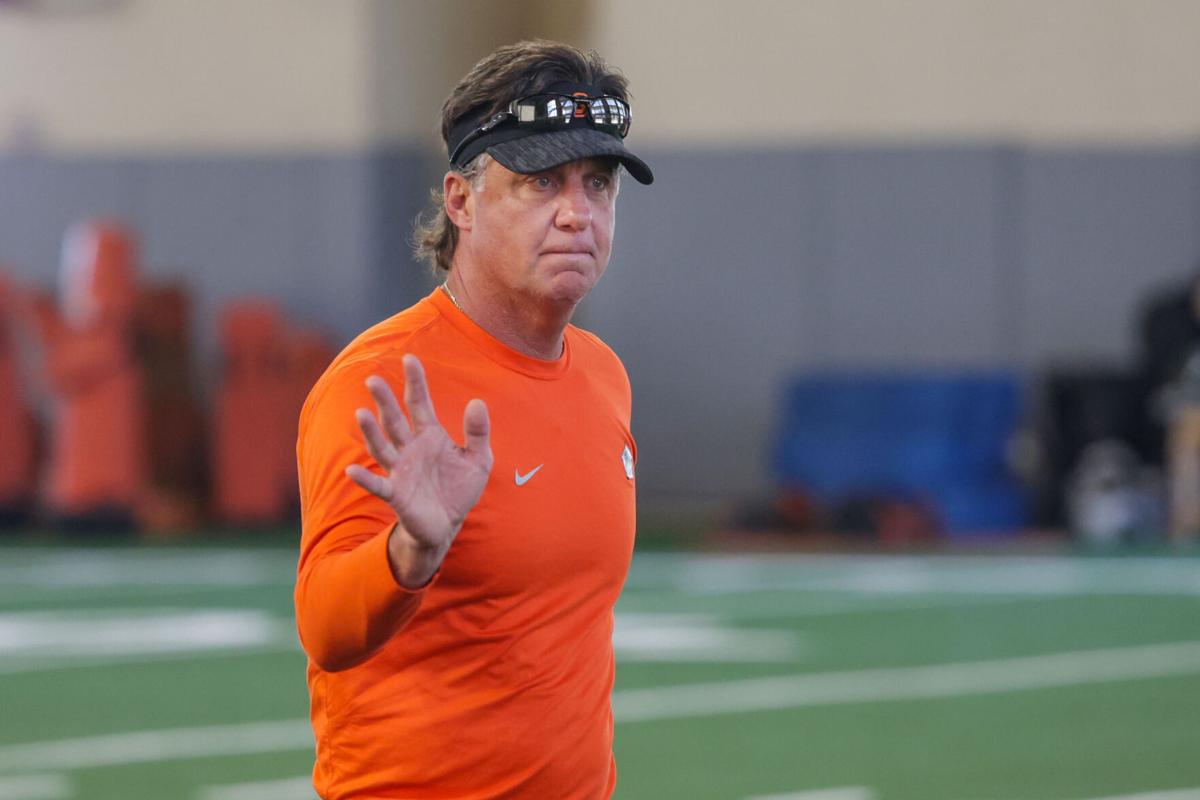
Prior to Mike Gundy’s 20th season as head coach of the Oklahoma State football team, the team has hired another member to its coaching staff.
According to the program, Sean Snyder will be joining the staff to train the Cowboys’ punters and kickers on Wednesday.
Snyder most recently assisted with the Jayhawks’ special teams while serving as the head coach’s special assistant at Kansas during the previous campaign. After the season, he moved out to launch his own kicking camps.
“Sean brings years of experience with kickers and punters and special teams concepts,” Gundy stated. “We’re really excited about what he brings to our coaching staff.”
After serving in the same capacity for two seasons at USC, Snyder was the special teams coordinator at Illinois in 2022 before moving to Lawrence. Sean Snyder, a renowned Kansas State coach’s son, worked in Manhattan for almost thirty years in a variety of capacities. All-American punter from 1990 to 1992, deputy athletic director for football operations from 1996 to 1998, director of football operations from 1996 to 1998, associate athletic director for football operations from 2001 to 2010, and senior associate athletic director from 2002 to 2010 were some of his roles. Then, from 2011 to 2018, he served as K-State’s special teams coordinator and associate head coach. In 2019, he assumed the position of special teams analyst.
Five times while playing for the Wildcats, Snyder assisted Kansas State in being among the top 15 teams in ESPN’s special teams effectiveness rating. FootballScoop and Phil Steele named him the 2015 and 2017 national Special Teams Coordinator of the Year, respectively.
In 1992, as a senior at Kansas State, Snyder averaged 44.7 yards per punt and was selected by his father, Bill Snyder, as a consensus All-American and All-Big Eight first team punter. With a punting average of 40.5, he won the Big Eight Defensive Newcomer of the Year award in 1991 as a junior. His career punting average of 43.0 set a record for the institution. He participated in the Blue-Gray Game in 1992. He was admitted into the Kansas State Athletics Hall of Fame in 2016 and the university’s inaugural Ring of Honor Class in 2002.
In 1993, Snyder signed as a free agent with the Arizona Cardinals, then in 1994, he signed with the San Diego Chargers. He raised sons Tate and Matthew and daughter Katherine with his wife Wanda. They have multiple grandchildren as well.

After defensive line coach Paul Randolph was hired in January, Snyder is the second position coach hired this offseason. Alex Hale, a veteran kicker for the Cowboys who played for Oklahoma State from 2019 to 2023, will need to be replaced. Hale finished as a semifinalist for the Lou Groza award last season, making 27 field goals and 36 extra points. He was also named to the Second Team All-Big 12.
In 2024, a number of their current kickers and punters—Hudson Kaak, Wes Pahl, Logan Ward, Thomas Murray, Kason Shrum, and Sam Babbush—will compete for playing time.
Reasonable expectations for each Big 12 basketball transfer in 2024–25.
There is no shortage of clubs in the Big 12, and they should be extremely proud of their accomplishments when they close out the 2024 transfer portal cycle. After posting its worst Big 12 record under Bill Self, Kansas made a bold move by bringing in skilled bucket-getters to significantly boost its star power. To have a chance in the first year and to develop some long-term players into a team with any sort of longevity, Darian DeVries, the new coach at West Virginia, needed superstars. WVU succeeded in achieving both goals.
Houston acquired a competent point guard, much needed. Baylor added two of the nation’s top transfers to its impressive class of recruits. Jerome Tang will give Kansas State the new beginning they sorely needed. The star of K-State’s sensational transfer haul is Coleman Hawkins and his $2 million+ NIL contract. Through the gateway, teams like Arizona, Texas Tech, and Cincinnati were able to fill up their holes with expected game-changers.
This league will soon turn into a bear. According to Bart Torvik’s early 2025 estimates, nine Big 12 clubs are ranked in the top-30 nationally.
The hits—and misses—of the transfer site will be particularly noticeable.
Let’s examine the reasonable expectations for every one of the 77 transfers who will play in the Big 12 in the upcoming season.
Role anticipated: starting guard
Although it isn’t getting much attention nationally, Arizona’s outside shooting, excluding Caleb Love, is becoming a significant concern. Trey Townsend, Jaden Bradley, and KJ Lewis are all low-volume 3-point shooters. Dell’Orso plays a significant role in this roster construction because of this.
To relieve some of the burden on Love to make 3-pointers and provide space for Bradley’s drives and Arizona’s army of large men, he just needs to shoot it at a high level.
The 6-foot-6 Australian shot just less than 39% of his 3-pointers from catch-and-shoot last season at Campbell. He has a good handling and a stepback jumper that he can control, which makes him a formidable cover. Dell’Orso was a massive 29% usage rate at Campbell with the ball in his hands all the time. At Arizona, it probably won’t be the case. Dell’Orso can contribute in an off-the-ball, spot-up role for Tommy Lloyd, but he can also go get a bucket for himself late in the game.
Although Dell’Orso is quite long, his subpar athleticism may prove to be a liability in the Big 12. Although he is now a below-the-rim athlete and doesn’t generate a lot of space on drives, he shot 64% at the rim when playing at a high volume. If he gains physical improvement, that would significantly alter his ceiling.
However, he occupies a crucial position as the second perimeter shooter you need to cover. Because of how distinct his skill set is from Arizona’s other guards, he’s a safe bet to start.
Role anticipated: moving forward
Townsend is traveling to Arizona to get started, but he will face challenges as five-star rookie Carter Bryant is eager to claim a significant position. Townsend is a bit of an unusual hooper and a tweener. However, when a smart coach like Lloyd pairs up with a clever player like Townsend, wonderful things usually happen.
The 6’6″, 228-pound forward is more of a wing handler who can consistently generate opportunities rather than a stretch four, even though he has made 50 3-pointers in 126 games. He fits the model of a Jaime Jaquez-lite in that he is a superb post-up weapon, competent cutter, and wise decision-maker who won’t damage you. Townsend will need to adjust slightly to Arizona’s fast tempo because he is accustomed to playing slowly at Oakland. However, he ought to be able to provide Lloyd with an additional choice that allows him to quickly take off the glass and enter his post-ups. Townsend excels at drawing a second defender and taking the ball away from him.
Last year, Arizona’s halfcourt offense was only passable. According to Synergy, Arizona’s points per possession in halfcourt situations fell outside the top-60 nationally. Arizona’s outstanding transition offense contributed to their 11th-place offensive efficiency overall, but there were instances where Arizona’s play may falter. Townsend could be a component of the answer. Another halfcourt facilitator who can win one-on-one games and get to the free throw line without the need for a play to be designed for him is Townsend.
Tobe Awaka, a Tennessee native
Role expected: rotation in the frontcourt, possibly starting
Awaka left Tennessee to probably take on a slightly larger role at Arizona, where he was a rotational player. Krivas would allow Awaka to move into a true platoon at the center. They could divide those forty minutes rather easily.





